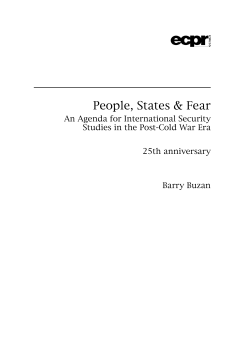
Additional Information
Book Details
Abstract
The second edition of this widely acclaimed book takes as its main theme the question of how states and societies pursue freedom from threat in an environment in which competitive relations are inescapable across the political, economic, military, societal and environmental landscapes. Throughout, attention is placed on the interplay of threats and vulnerabilities, the policy consequences of overemphasising one or the other, and the existence of contradictions within and between ideas about security. Barry Buzan argues that the concept of security is a versatile, penetrating and useful way to approach the study of international relations. Security provides an analytical framework which stands between the extremes of power and peace, incorporates most of their insights and adds more of its own. People, States and Fear is essential reading for all students and researchers of international politics and security studies. The ECPR Classics edition includes a new introduction from the author placing this classic text within a current context.
Table of Contents
| Section Title | Page | Action | Price |
|---|---|---|---|
| Title Page | i | ||
| Copyright Page | ii | ||
| Series Page | iii | ||
| contents | v | ||
| new introduction by the author | 1 | ||
| preface to the first edition | 17 | ||
| preface to the second edition | 19 | ||
| figures and tables | 23 | ||
| introduction | 25 | ||
| THE NATIONAL SECURITY PROBLEM IN INTERNATIONAL RELATIONS | 25 | ||
| SECURITY AS AN UNDERDEVELOPED CONCEPT | 26 | ||
| DEVELOPMENTS DURING THE 1980s | 32 | ||
| THE APPROACH OF THIS BOOK | 34 | ||
| THE STRUCTURE OF THIS BOOK | 42 | ||
| chapter one: individual security and national security | 49 | ||
| INDIVIDUAL SECURITY AS A SOCIETAL PROBLEM | 49 | ||
| INDIVIDUAL SECURITY AND THE TWO FACES OF THE STATE | 52 | ||
| THE STATE AS A SOURCE OF THREAT | 55 | ||
| CONCLUSIONS: INDIVIDUAL SECURITY AND NATIONAL SECURITY | 59 | ||
| chapter two: national security and the nature of the state | 65 | ||
| IDENTIFYING THE STATE AS AN OBJECT OF SECURITY | 65 | ||
| THE IDEA OF THE STATE | 74 | ||
| THE INSTITUTIONS OF THE STATE | 83 | ||
| THE PHYSICAL BASE OF THE STATE | 88 | ||
| CONCLUSIONS: WEAK AND STRONG STATES | 92 | ||
| chapter three: national insecurity: threats and vulnerabilities | 104 | ||
| THREATS AND VULNERABILITIES | 104 | ||
| TYPES OF THREAT BY SECTOR | 107 | ||
| THE OPERATION OF THREATS | 119 | ||
| CONCLUSIONS: THE AMBIGUITY OF THREATS | 124 | ||
| chapter four: security and the international political system | 128 | ||
| THE NATURE OF THE INTERNATIONAL ANARCHY | 128 | ||
| THE CHARACTER OF STATES | 133 | ||
| THE USES AND LIMITATIONS OF SYSTEM STRUCTURE IN SECURITY ANALYSIS | 138 | ||
| INTERNATIONAL SOCIETY | 142 | ||
| CONCLUSIONS: ANARCHY AND SECURITY | 148 | ||
| chapter five: regional security | 157 | ||
| FILLING THE GAP BETWEEN STATE AND SYSTEM LEVELS: SECURITY COMPLEXES | 157 | ||
| A BRIEF HISTORY OF REGIONAL SECURITY | 168 | ||
| SECURITY COMPLEXES AS STRUCTURES: THE PROCESSES AND OUTCOMES OF CHANGE | 173 | ||
| CONCLUSIONS: SECURITY COMPLEXES AND POLICY ANALYSIS | 182 | ||
| chapter six: economic security | 189 | ||
| THE NATURE OF THE INTERNATIONAL POLITICAL ECONOMY | 189 | ||
| THE IDEA OF ECONOMIC SECURITY | 192 | ||
| ECONOMIC SECURITY AND THE STATE | 197 | ||
| ECONOMIC SECURITY AND THE INTERNATIONAL SYSTEM | 202 | ||
| CONCLUSIONS: PROSPECTS FOR THE POLITICAL ECONOMY OF A MATURE ANARCHY | 210 | ||
| chapter seven: the defence dilemma | 217 | ||
| THE DEFENCE DILEMMA DEFINED | 218 | ||
| THE HISTORICAL DEVELOPMENT OF THE DEFENCE DILEMMA | 221 | ||
| THE DURABILITY OF THE DEFENCE DILEMMA | 228 | ||
| CONCLUSIONS: THE DEFENCE DILEMMA AND SECURITY | 230 | ||
| chapter eight: the power-security dilemma | 234 | ||
| THE POWER AND SECURITY STRUGGLES | 234 | ||
| REVISIONISM VERSUS STATUS QUO | 237 | ||
| THE NATURE OF REVISIONISM | 241 | ||
| THE MILITARY FACTOR | 246 | ||
| CONCLUSIONS: CAN THE POWER-SECURITY DILEMMA BE RESOLVED? | 252 | ||
| chapter nine: national and international security: the policy problem | 258 | ||
| LOGICAL PROBLEMS | 259 | ||
| PERCEPTUAL PROBLEMS | 269 | ||
| POLITICAL PROBLEMS | 272 | ||
| CONCLUSIONS: POLICY-MAKING AS PART OF THE NATIONAL SECURITY PROBLEM | 277 | ||
| chapter ten: concluding thoughts on international security studies | 283 | ||
| OVERVIEW: THE AGENDA OF SECURITY | 283 | ||
| REASONS FOR ADOPTING, AND CONSEQUENCES OF, A BROAD INTERPRETATION OF SECURITY | 287 | ||
| IMPLICATIONS FOR POLICY | 291 |
